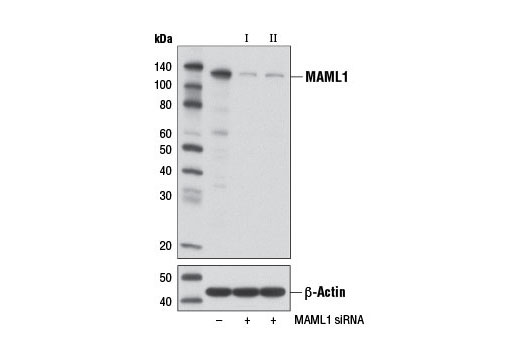#Q92585
9794
Product Information
Product Usage Information
CST recommends transfection with 100 nM SignalSilence® MAML1 siRNA I 48 to 72 hours prior to cell lysis. For transfection procedure, follow protocol provided by the transfection reagent manufacturer. Please feel free to contact CST with any questions on use.
Each vial contains the equivalent of 100 transfections, which corresponds to a final siRNA concentration of 100 nM per transfection in a 24-well plate with a total volume of 300 μl per well.
Storage
Specificity / Sensitivity
Species Reactivity:
Human
Species predicted to react based on 100% sequence homology
The antigen sequence used to produce this antibody shares
100% sequence homology with the species listed here, but
reactivity has not been tested or confirmed to work by CST.
Use of this product with these species is not covered under
our
Product Performance Guarantee.
Monkey
Product Description
Background
Mastermind-like (MAML) family of proteins are homologs of Drosophila Mastermind. The family is composed of three members in mammals: MAML1, MAML2, and MAML3 (1,2). MAML proteins form complexes with the intracellular domain of Notch (ICN) and the transcription factor CSL (RBP-Jκ) to regulate Notch target gene expression (3-5). MAML1 also interacts with myocyte enhancer factor 2C (MEF2C) to regulate myogenesis (6). MAML2 is frequently found to be fused with Mucoepidermoid carcinoma translocated gene 1 (MECT1, also know as WAMTP1 or TORC1) in patients with mucoepidermoid carcinomas and Warthin's tumors (7).
- Wu, L. et al. (2002) Mol. Cell Biol. 22, 7688-7700.
- Lin, S.E. et al. (2002) J. Biol. Chem. 277, 50612-50620.
- Kitagawa, M. et al. (2001) Mol. Cell Biol. 21, 4337-4346.
- Nam, Y. et al. (2003) J. Biol. Chem. 278, 21232-21239.
- Nam, Y. et al. (2006) Cell 124, 973-983.
- Shen, H. et al. (2006) Genes Dev. 20, 675-688.
- Tonon, G. et al. (2003) Nat. Genet. 33, 208-213.
Species Reactivity
Species reactivity is determined by testing in at least one approved application (e.g., western blot).
Cross-Reactivity Key
H: human M: mouse R: rat Hm: hamster Mk: monkey Vir: virus Mi: mink C: chicken Dm: D. melanogaster X: Xenopus Z: zebrafish B: bovine Dg: dog Pg: pig Sc: S. cerevisiae Ce: C. elegans Hr: horse GP: Guinea Pig Rab: rabbit All: all species expected
Trademarks and Patents
Limited Uses
Except as otherwise expressly agreed in a writing signed by a legally authorized representative of CST, the following terms apply to Products provided by CST, its affiliates or its distributors. Any Customer's terms and conditions that are in addition to, or different from, those contained herein, unless separately accepted in writing by a legally authorized representative of CST, are rejected and are of no force or effect.
Products are labeled with For Research Use Only or a similar labeling statement and have not been approved, cleared, or licensed by the FDA or other regulatory foreign or domestic entity, for any purpose. Customer shall not use any Product for any diagnostic or therapeutic purpose, or otherwise in any manner that conflicts with its labeling statement. Products sold or licensed by CST are provided for Customer as the end-user and solely for research and development uses. Any use of Product for diagnostic, prophylactic or therapeutic purposes, or any purchase of Product for resale (alone or as a component) or other commercial purpose, requires a separate license from CST. Customer shall (a) not sell, license, loan, donate or otherwise transfer or make available any Product to any third party, whether alone or in combination with other materials, or use the Products to manufacture any commercial products, (b) not copy, modify, reverse engineer, decompile, disassemble or otherwise attempt to discover the underlying structure or technology of the Products, or use the Products for the purpose of developing any products or services that would compete with CST products or services, (c) not alter or remove from the Products any trademarks, trade names, logos, patent or copyright notices or markings, (d) use the Products solely in accordance with CST Product Terms of Sale and any applicable documentation, and (e) comply with any license, terms of service or similar agreement with respect to any third party products or services used by Customer in connection with the Products.
